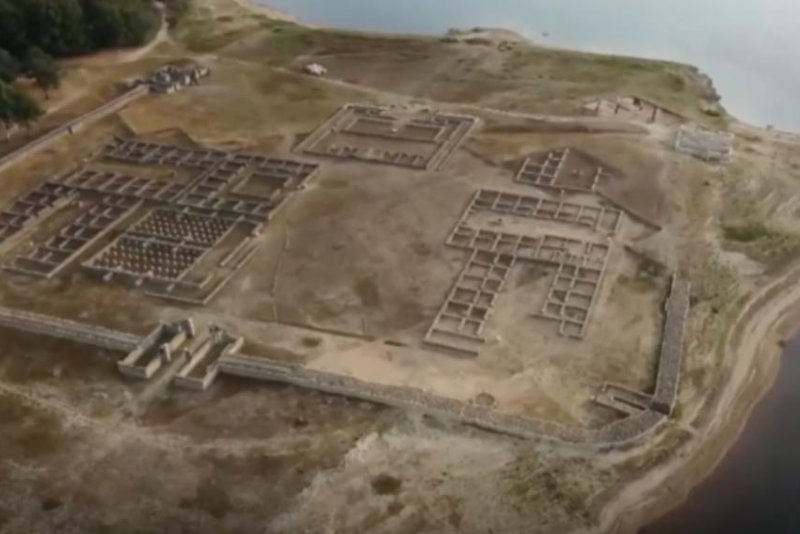An aerial photo shows Aquis Querquennis, an ancient Roman military camp that dates back to the first century. Photo by EFE
Aug. 30 -- An ancient Roman military camp in what is now northwestern Spain has been revealed in its entirety as reservoirs in Europe continue to shrink this month amid record-breaking drought.
Portions of columns, arches and the foundation are all that remain of Aquis Querquennis, a fort and military barracks for Roman legions that were likely stationed there to monitor the construction of roads.
The fort was constructed along the Lima River in what is now known as Galicia, an autonomous region in northwestern Spain, and its occupation lasted from around 75 A.D. until it was abandoned less than a century later, according to a 2018 study.
Locally, the site is known as A cidá, or "the city," though it is often submerged beneath the As Conchas Reservoir following its construction in 1949.
Over years past, portions of pillars and archways would break the surface as water levels dropped. Then in August 2022, as the reservoir's water levels receded to just 49% of the maximum level, the lake yielded the entirety of the camp.
This is not the first ancient relic to be unveiled this summer. Shrinking rivers and lakes across Europe have revealed a number of lost relics, from a World War II-era barge unearthed in Italy's Po River to "Hunger Stones" in the Elbe River, the last readable inscriptions dating back to the 15th century.
Now in Ourense, Galicia, aerial photographs show the bare bones of the sunken city, the remaining foundation outlining what past researchers have identified as granaries, a basilica and temple, an infirmary and three barracks that were capable of holding two centuria with their respective commanders. It took a historically severe drought to reach this point, however.
The ongoing drought in Europe is expected to be one of the worst in 500 years, scientists at the European Drought Observatory said in early August.
At least 47% of Europe is under drought warning conditions, the second of three drought categories, according to the Observatory. Another 17% of Europe is under alert conditions, the most severe category, and drought hazard continues to increase in a handful of nations, including Spain.
In Madrid, over 250 miles from the site, rainfall from May through Aug. 28 was only 7% of average, and for the same time period, the temperature was 8.4 degrees Fahrenheit above average according to AccuWeather Senior Meteorologist John Gresiak.
Spain, Portugal, France and the United Kingdom all saw temperatures measure over 104 degrees and the Iberian Peninsula saw multiple days with maximum temperatures above 95 degrees as a long-lasting heat wave baked the region.
July was the hottest month ever recorded for Spain, according to the Spanish National Meteorological Service, and was one of the three warmest Julys on record, globally.















